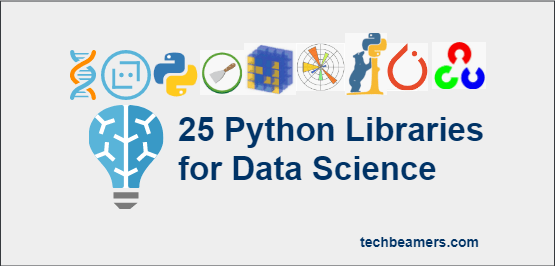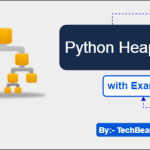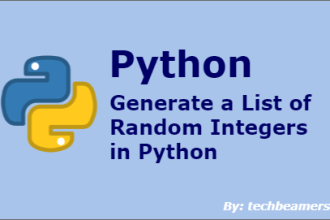This post is attempting to enlighten you about the most useful and popular Python libraries used by data scientists. And why only Python, because it has been the leading programming language for solving real-time data science problems?
- Top Python Libraries You Should Use for Data Science
- Python Libraries Used for Data Collection
- Best Libraries for Data Cleaning and Rinsing
- Essential Libraries for Data Visualization
- Python Libraries for Data Modeling
- Libraries to Check Interpretability of Models
- Libraries You Need for Manipulating Audio
- Python Libraries for Media (Images) Processing
- Database Communication Libraries
- Python Libraries for Web Deployment
- Summary: Top Python Libraries for Data Science

These libraries have been tested to give excellent results in various areas like Machine Learning (ML), Deep Learning, Artificial Intelligence (AI), and Data Science challenges. Hence, you can confidently induct any of these without putting too much time and effort into R&D.
In every data science project, programmers, even architects, spend considerable time researching the Python libraries that can be the best fit. We believe this post might give them the right heads up, cut short the time spent, and let them deliver projects much faster.
Top Python Libraries You Should Use for Data Science
Please note that while working on data science projects, you have several tasks at hand. Hence, you can and should divide them into different categories. Therefore, it becomes smoother and more efficient for you to distribute and manage progress.
Therefore, we’ve also fine-tuned this post and divided the set of Python libraries into these task categories. So, let’s begin with the first thing you should be doing:
Python Libraries Used for Data Collection
Lack of data is the most common challenge that a programmer usually faces. Even if s/he has access to the right set of data sources, they are not able to extract the appropriate amount of data from there.
That’s why you must learn different strategies to collect data. It has even become the core skill towards becoming a sound machine learning engineer.
So, we’re here to bring three essential and time-tested Python libraries for scraping and collecting data.
Selenium Python
Selenium is a web test automation framework, that was initially created for Software testers. It provides Web Driver APIs for browsers to interact with user actions and return responses.
It is one of the coolest tools for web automation testing. However, it is quite rich in functionality, and one can easily use its APIs to create web crawlers. We have provided in-depth tutorials to learn to use Selenium Python.
Please go through the linked tutorials and design an excellent online data collection tool.
Scrapy
Scrapy is another Python framework that you can use for scraping data from multiple websites. With this, you get a variety of tools to efficiently parse data from websites, process on-demand, and store it in a user-defined format.
It is simple, fast, and open-source written in Python. You can enable selectors (such as XPath, and CSS) to extract data from the web page.
Beautiful Soup
This Python library implements excellent functionality to scrap websites and collect data from web pages. Also, it is perfectly legal and authentic to do so as the information is already publicly available.
Moreover, if you attempt to download data manually, then it becomes hectic and time-intensive. Nonetheless, Beautiful Soup is available for you to do this cleanly.
Beautiful Soup has a built-in HTML and an XML parser that crawls websites, parses data, and stores it in parse trees. This entire process, from crawling to data collection, is known as Web Scraping.
It is super easy to install all the above three Python libraries by using the Python package manager (pip).
Best Libraries for Data Cleaning and Rinsing
After completing the data collection, the next step is to filter out the anomalies by performing cleaning and rising. It is the mandatory step to follow before you can use this data for building/training your model.
We’ve inducted the following four libraries for this purpose. Since the data can be both structured and non-structured, you may need to use a combination to prepare an ideal data set.
Spacy
Spacy (or spaCy) is an open-source library package for Natural Language Processing (NLP) in Python. Cython is used to develop it and also added a unique ability to extract data using natural language understanding.
It provides a standardized API set that is easy to use and fast as compared to other competitive libraries.
What spaCy can do:
- Tokenization – Segment raw text into words, and punctuation marks.
- Tagging – Assign word types to a verb or noun.
- Dependency Parsing – Assign labels to define relationships between subjects or objects.
- Lemmatization – Resolve words to their dictionary form, like resolving
"is"and"are"=>"be."
There are more things that spaCy can do that you can read from its website.
NumPy
NumPy is a free, cross-platform, and open-source Python library for numerical computing. It implements a multi-dimensional array and matrix-styled data structures.
You can get it to run a large number of mathematical calculations on arrays using trigonometric, statistical, and algebraic methods. NumPy is a descendant of Numeric and numarray.
What does NumPy provide?
- Support for multi-dimensional data structures (arrays) via functions & operators
- Support of trigonometric, statistical, and algebraic operations
- Built-in random number generators
- Fourier transform & shape manipulation
Pandas
Pandas is a Python Data Analysis Library written for data munging. It is a free, open-source, and BSD-licensed package that enables high-performance, easy-to-use data structures, and data tools.
Pandas library is an extension to NumPy, and both these are part of the SciPy stack. It makes heavy use of NumPy arrays for data manipulation and computation.
Majorly, the Pandas library provides data frames that you can use to import data from various data sources such as CSV, excel, etc.
Why should you use Pandas?
- It can read large CSV files (using chunk size) even if you are using a low-memory machine.
- You can filter out some unnecessary columns and save memory.
- Changing data types in Pandas is hugely helpful and saves memory.
Pandas Library provides all the features that you need for data cleaning and analysis. And it can certainly improve the computational efficiency.
PyOD
PyOD is an excellent Python Outlier Detection (PyOD) library. It efficiently works on an extensive multivariate data set to detect anomalies.
It supports many outlier detection algorithms (approx. 20), both standard and some quite recent neural network-based ones. Also, it has a well-documented and unified API interface to write cleaner and more robust code.
Anomaly detection is a mechanism to find outliers in the data set. Outliers are the data points that are a complete mismatch from the rest of the observations in the data set.
PyOD library helps you execute the three main steps for anomaly detection:
- Build a model
- Define a logical boundary
- Display the summary of the standard and abnormal data points
Please note that the PyOD library is compatible with both Python2 and Python3 and that too across major operating systems.
Essential Libraries for Data Visualization
Data science and data visualization complement each other. They aren’t two different things. The latter is a sub-component of data science.
Also, data visualization is an exciting aspect of the entire data science workflow. It provides a representation of the hypotheses to analyze, identify patterns, and conclude some facts.
Below is the list of the top three Python libraries to simplify data visualization.
Matplotlib
Matplotlib is the most popular plotting library for visualization in Python. It can produce all kinds of plots for a vast amount of data with easily understandable visuals.
It supports several plots like the line, bar, scatter plots, and histograms. Moreover, it has an object-oriented API interface that can be used to insert graphs into GUI applications such as Tkinter, Qt, wxPython, GTK+, etc.
You can add grids, set legends, and labels effortlessly using the Matplotlib library. The following are some of the attributes of the plots created using it:
- Varying density
- Varying colors
- Variable line width
- Controlling starting/ending points
- Streamplot with masking
Seaborn
Seaborn is a Python library for providing statistical data visualization. It can produce highly effective plots with more information embedded into them.
It is developed on top of Matplotlib and uses pandas’ data structures. Also, it provides a much higher level of abstraction to render complex visualizations.
Matplotlib vs. Seaborn
- Matplotlib is all about creating basic plots that include bars, pies, lines, scatter charts, and so on. On the other hand, Seaborn extends the plotting to a much higher level with several patterns.
- Matplotlib makes use of data frames and arrays, whereas Seaborn operates on the entire dataset and handles many things under the hood.
- Pandas library makes use of Matplotlib. It is a thin wrapper over Matplotlib. On the other hand, Seaborn works on top of Matplotlib to solve specific use cases via statistical plotting.
- It is quite easy to customize Matplotlib with its limited features, whereas Seaborn has a lot to offer apart from the default stuff.
Python Libraries for Data Modeling
Data modeling is a crucial stage for any data science project. It is the step where you get to build the machine learning model.
So, let’s now discover the necessary Python libraries required for model building.
Scikit-learn
Scikit-learn is the most useful, open-source Python library for machine learning. It packages some incredible tools for analyzing and mining data.
It works on top of the following Python machine-learning libraries: NumPy, SciPy, and matplotlib. Both supervised and unsupervised learning algorithms are available.
Scikit-learn Python library bundles the following features:
- Vector machines, Nearest neighbors, and Random forests for data classification
- SVMs, Ridge regression, and Lasso for regression
- K-means, Spectral clustering, and Mean-shift to group data with similar characteristics
- Principal component analysis (PCA), feature selection, and NNMF for reducing random variables
- Grid search, Cross-validation, and Metrics for comparing, validating, and selecting the best parameters
- Preprocessing and Feature extraction for Feature extraction and normalization
PyTorch
PyTorch is an open-source Python library and works on top of the Torch library. It caters to various applications like computer vision and NLP (natural language processing). Initially, it was the initiative of Facebook’s artificial intelligence (AI) research group to build it.
This library offers two high-level features:
- Tensor computing with high acceleration utilizing graphics processing units (GPU)
- Deep neural networks (Using a tape-based auto diff system)
PyTorch developer provisioned this library to run numerical operations quickly. And, the Python programming language complements this methodology. It makes machine learning engineers run, debug, and test part of the code in real time. Therefore, they can identify any problem even when the execution is in progress.
Some of the critical highlights of PyTorch are:
- Simple Interface – The API set is quite easy to integrate into Python programming.
- Pythonic Style – It smoothly gels into the Python data science stack. Therefore, all the services and features are accessible by default.
- Computational Graphics – PyTorch gives a platform to generate dynamic computational charts. It means you can update them while running.
TensorFlow
TensorFlow is a free and open-source Python library for fast numerical computing. It is used to create Deep Learning models and machine learning apps like neural networks. Initially, its development began at Google, and later, it was open for public contribution.
TensorFlow Cool Facts
- TensorFlow gives you the ability to design machine learning algorithms, whereas
scikit-learnprovides out-of-the-box algorithms such as SVMs, Logistic Regression (LR), Random Forests (RF), etc. - It is undoubtedly the best deep learning framework. Giants like Airbus, IBM, Twitter, and others are using it due to its highly customized architecture.
- While TensorFlow produces a static graph, PyTorch provides dynamic plotting.
- TensorFlow comes with TensorBoard, an excellent tool for visualizing ML models, whereas PyTorch doesn’t have any.
Libraries to Check Interpretability of Models
Every data scientist should know how efficient his/her model is. So, we’ve listed down two Python libraries that could help you evaluate a model’s performance.
Lime
LIME is a Python library that intends to verify a model’s interpretability by giving locally reliable explanations.
It implements the LIME algorithm that aims to tell the predictions. How does LIME achieve this? By guesstimating it locally with the help of an interpretable model. It has an interpreter to produce explanations for a classification algorithm.
This technique tries to follow the model by changing the input data and learning how that impacts. For example, LIME changes a data sample by playing with the feature values and observes the impact on the result.
Often, it relates to what a human would do by assessing the output of a model.
H2O
H2O is a well-known, open-source, and distributed in-memory Python library with linear scalability. It incorporates the most widely used numeric & machine learning algorithms and even provides AutoML functionality.
Key Features of H2O
- Leading Algorithms – RF, GLM, GBM, XG Boost, GLRM, etc.
- Integrate with R, Python, Flow, and more
- AutoML – Automating the machine learning workflow
- Distributed, In-Memory Processing – 100x faster with fine-grain parallelism
- Simple Deployment – POJOs and MOJOs to deploy models for fast and accurate scoring
Libraries You Need for Manipulating Audio
The audio signal is also a source for data analysis and classification. It is getting a lot of attention in the deep learning field. The following libraries can help:
Librosa
LibROSA is a Python library for voice (music and audio) analysis. It packages the required tools for managing music information.
Madmom
Madmom is another library written in Python for audio signal processing. It also provides dedicated functions for handling music information retrieval (MIR) tasks.
Some of the notable consumers of this library are:
- The Department of Computational Perception, Johannes Kepler University, Linz, Austria
- The Austrian Research Institute for Artificial Intelligence (OFAI), Vienna, Austria
pyAudioAnalysis
This library can execute a wide range of audio analysis tasks.
- Parse audio features and thumbnails
- Classify unfamiliar sounds
- Identify audio events and ignore idle periods
- Perform supervised/unsupervised segmentation
- Train audio regression models
- Dimensional reduction
Python Libraries for Media (Images) Processing
Media or images are sometimes a great source of information. They may contain valuable data points that become critical for some applications. Hence, it is a mandatory requirement that you know how to process them.
Here are three Python libraries to help you out:
OpenCV-Python
OpenCV is a reliable name in the field of image processing. OpenCV-Python is the Python library that provides functions for parsing an image.
It uses NumPy under the hood. Finally, all OpenCV’s Python data types convert to the NumPy data structure.
Scikit-image
Another excellent library that could decipher images pretty well is Scikit-image. It implements a set of algorithms that address different types of image-processing problems.
For example, some are used for image segmentation, some of them perform geometric transformations, and it has more to do with analysis, feature detection, filtering, etc.
It makes use of NumPy and SciPy libraries for statistical and scientific purposes.
Database Communication Libraries
Being a data scientist, you must be aware of different strategies to store data. This skill is crucial because one needs information at every point in time during the entire data science workflow.
You could go on building a great model, but without data, it isn’t going to yield anything. So, here are a couple of libraries to help you out:
Psycopg
PostgreSQL is the most reliable database management system. It is free, open-source, and robust. If you wish to use it as the backend for your data science project, then you need Psycopg
Psycopg is a database adaptor for PostgreSQL written in Python programming language. This library provides functions confirming Python DB API 2.0 specifications.
This library has native support for heavily multi-threaded applications that require concurrent INSERTs or UPDATEs and closing a lot of cursors.
SQLAlchemy
SQLAlchemy is the Python library that implements classes and functions to run SQL queries and use SQLite.
SQLite is another quite popular database that is used in abundance. It is included within Python, doesn’t require a server, and operates very fast. Also, it stores in a single disk file image.
Python Libraries for Web Deployment
An end-to-end machine learning solution would require you to implement a web interface with screens to interact with end users. For this, you have to select a web development framework that would help you create UI and database integration.
Let’s talk about a couple of WDFs in the below section:
Flask
Flask is a web app development framework. You can use it to create and deploy web applications. It bundles a plethora of tools, libraries, and scripts to simplify development.
It is created using Python and is quite famous for deploying data science models. The following are two of its main components:
One of them is the Werkzeug WSGI toolkit, and the other is a Jinja2 template engine. It is an extensible microframework that doesn’t enforce any particular code structure.
You can install Flask using the following command:
# Install Flask pip install Flask
Django
Django is a full-stack web framework for faster development and building of large applications. The developers can utilize it not only for development but also for designing as well.
# Install Django pip install Django
Pyramid
The pyramid framework is compact and a bit faster than its counterparts. It is a byproduct of the Pylons Project. By the way, it is open-source and enables web developers to create apps with ease.
It is quite easy to set up this framework on Windows.
# Install Pyramid set VENV=c:\work mkdir %VENV% python -m venv %VENV% cd %VENV% %VENV%\Scripts\pip install "pyramid==ver"
Summary: Top Python Libraries for Data Science
While writing this article, we have done our best to bring the top 25 Python libraries used for data science projects. The original list was even longer, but you see here the ones that most data science professionals either recommend or use themselves.
Anyway, if you feel that we have missed a Python library that you would like to see on this page, then do let us know.
Enjoyed this tutorial? Help us keep our site free and accessible for everyone! If you found this guide helpful, please:
1️⃣ Share it on LinkedIn or Facebook to spread the knowledge.
2️⃣ Subscribe to our YouTube channel for more in-depth tutorials and tips!
Enjoy Coding,
TechBeamers





